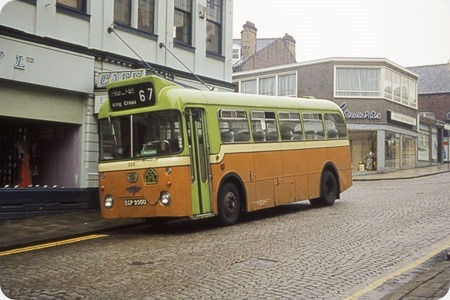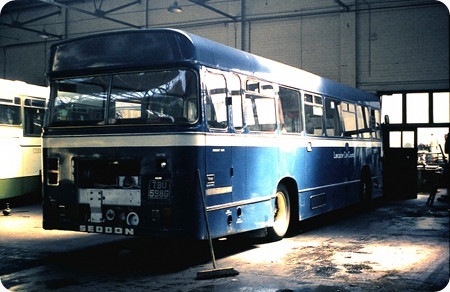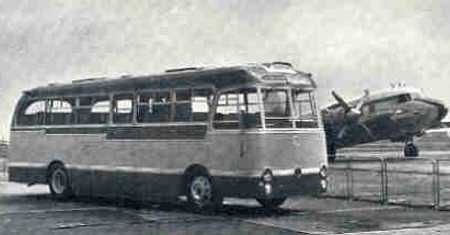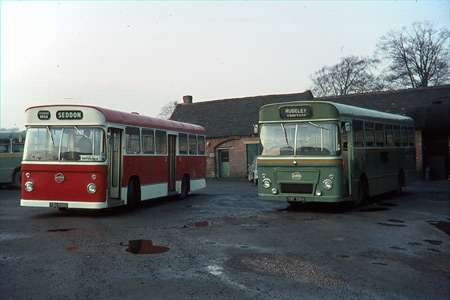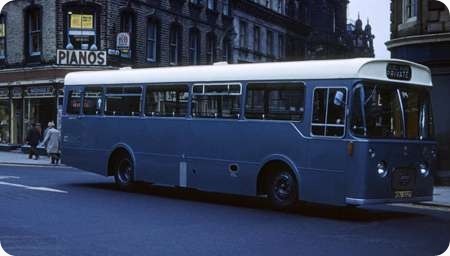

Demonstrator
1968
Seddon Pennine IV
Pennine B45F
Something to give Roger Cox the shudders ! In late 1968 Halifax Corporation borrowed the prototype
Seddon Pennine IV demonstrator, though I wonder if the intention was simply to give the manufacturer
some operational experience of their new model. Surely manager Geoff Hilditch could never have been
serious about the department acquiring any. I believe this body design remained unique, as shortly
afterwards the model was offered as a complete item with a more distinctive style. Hilditch later
collaborated with Seddon in the introduction of the heavier duty rear-engined Pennine RU model, and the
prototype of that soon appeared in Halifax on trial.
In the first photo it is seen passing along Waterhouse Street in the town centre. In the second, rather
snatched and blurry shot, it is seen at speed on the A58 between Stump Cross and Hipperholme whilst
operating the dreaded Meredith & Drew private hire return journey.
Photograph and Copy contributed by John Stringer
25/08/13 - 11:32
Good to see this bus in reasonable condition. It later became Seddon’s own
works bus, used to bring staff to the factory off Shaw Road in Oldham. In this role it replaced the
earlier Seddon that ran as West Riding 738 (EHL 500). Both of these vehicles were clearly non-PSVs
as shown by their deteriorating condition. RBU 502F I don’t believe ever got repainted and ended up
with several plywood "windows". It was still there when I was in the late seventies.
David Beilby
25/08/13 - 14:53
How right you are, John. I consider the Pennine IV to have been the most
horrible vehicle of my experience, though the Cummins engined Leyland Lynx runs very close in second
place. It was basically a crude, fragile, lorry derived design with primitive suspension and decidedly
wayward steering characteristics. The ear splitting din from the Perkins 6.354 engine mounted in the
front overhang made the Regent V sound like a trolleybus by comparison. I cannot believe that, having
inspected this Emett inspired aberration, Geoff Hilditch even remotely considered it suitable for the
taxing topography of the Halifax bus network. Robert Seddon had been very supportive towards GGH at an
early stage of his engineering career, and it is fully understandable that he, GGH, would have wished
to assist in the development of Seddon’s more determined incursion into the main bus manufacturing
market. Though the Pennine IV sold reasonably well as a lightweight, medium duty coach, those who
acquired the thing as an inexpensive bus soon found that it was not up to the job. Seddon then went
on, with GGH’s encouragement, to produce the RU, and this, also, ultimately proved to be something of
a broken reed. Only the heavier weight Pennine VII produced for the Scottish Bus Group showed that the
firm could make a fully robust psv. I recall that my very first experience of a Seddon coach was in
1958, when, as an ATC cadet on summer camp at RAF Colerne, near Bath, I went on a chartered trip with
the rest of the squadron to Wookey Hole. The vehicle that took us was a Seddon, probably the R6
powered Mark 11, as it had the engine mounted under a rather high floor of a front entrance coach
body. My main recollection of the ride is the seemingly continual gearchanging (it had a two speed
axle into the bargain) required of the torqueless, screaming engine that kept the driver fully
employed throughout. I did take a picture of this machine with my Brownie 127, but the negative fell
somewhere by the wayside during parental home removals when I worked elsewhere in the land. I wonder
if anyone now can identify this beast or the operator.
Roger Cox
25/08/13 - 19:52
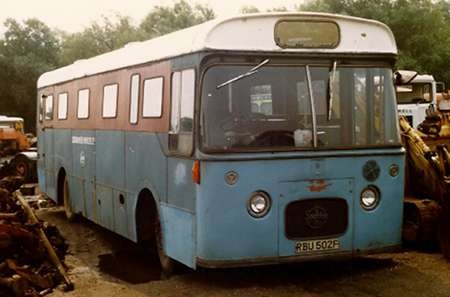
Here is a photo of RBU 502F, which I photographed in Fred Winters scrapyard at
North Cave in East Yorkshire, taken in 1982, still carries Seddon names on the side, but none
standard windows.
Mike Davies
26/08/13 - 17:12
It is interesting to note that the front wheels in particular are inboard of
the body sides by quite a margin. With the weight of the engine in the front overhang, a relatively
narrow track and presumably 8ft wide bodywork, does anyone know what it handled like?
Brendan Smith
27/08/13 - 05:39
Yes, Brendan. The Pennine IV handled like a pig. I drove one from Gomshall in
Surrey to Loughborough, and the steering needed constant correction to keep the thing in a straight
line, not helped by the bouncy suspension which could barely cope with the weight of the overhung
engine. It had the worst road behaviour of any vehicle I have ever driven.
Roger Cox
27/08/13 - 05:40
Didn’t KMB take 100 Pennine IVs with pretty-much off-the-peg Pennine bodywork
around 1970? I think the only concession to Hong Kong conditions were full-depth sliding windows,
whilst drivers sweltered behind BET windscreens, and the Perkins (V6?) engines sweltered behind
grilles designed for temperate climates . . . I think nearly all were rebuilt with in-house fronts
incorporating flat/opening windscreens and larger radiator grilles within a few years.
Halifax
JOC’s [sic] Pennine RUs had a high/flat floor (they were kitted-out as DPs): did they have a high
chassis frame or did Plaxton support the body floor in some way? and did any other RU operator opt
for this high floor line? They also had narrow two-piece glider doors - in short, non of the
advantages offered by the RU, but all the engineering problems . . . surely, Halifax’s usual
Leopard/Reliance chassis choice would have done the job better. What struck me when they were
introduced - and I was 5/6 at the time, so memory might be fading a bit here - was the way the lower
back panels stepped out and that they didn’t have "modern" rear lights but the
"old" two-piece/oblong units sort-of set into the rear panel . . . is anybody getting the
gist here? I’m wondering now, I think they’d be 10 metre, so the step-out couldn’t have compromised
length, but was it necessary to inset the rear lights into the body to accommodate the length of the
rear overhang? (presumably the RU, squeezing everything behind the rear axle, had a longish
overhang?). I think they may also have had coach-glasses below the rear window containing the
registration and, either side, the Halifax coat of arms . . . I’m sure that’s the case, because it
stuck in my young mind as being "inappropriate" for a bus (as opposed to a coach).
I
guess that if I could be bothered to trawl flickr etc then the answers might be there, but I can’t,
and anyway its much more interesting to see what this site might come up with . . . or not!
Philip Rushworth
27/08/13 - 11:40
There is a photo of mine posted on ‘another website’ showing a rear view
of one of the Halifax RU’s - complete with the stepped out panel. Here’s the link.
John Stringer
28/08/13 - 06:07
I didn’t move to Huddersfield until 1972 but I can’t recall the three Halifax
Seddons having this unusual rear end arrangement at that time. At the time of the PTE takeover (yes,
1974 and outside the strict remit of this site), Huddersfield had two further Seddon RUs on order to
be bodied by Pennine. We were instructed by Geoffrey Hilditch as PTE Engineering Director Designate
to transfer the body order to Plaxtons who produced bodies similar to those recently delivered to
Rotherham Corporation also on RU chassis. Whilst I can’t recall the floor layout, I am certain that
those buses did not have the protruding rear panels as shown on Halifax 315. Could these have been
to create a small luggage boot?? Engine access would have been restricted.
Ian Wild
28/08/13 - 06:09
Thanks for that, John - well, thanks for both sign-posting your photograph and
for having the fore-sight to photograph the rear-end, anticipating my musings of 40+ years later. In
my mind, the coach-glass just had the crests either side of the registration, but can I make out
Halifax in Gothic script above the registration? (the glass is deeper than I remembered); neither do
I remember the reversing lights, nor the removable centre panel, nor the
squared-off-compared-to-BET-standard rear window - but I think my memories were pretty accurate . .
. . now, if only my mother would have given-in to my entreaties to ‘ride on one of the
"white buses" to Huddersfield’ I might be able to recall what the interiors were like. The
final "Halifax Passenger Transport" timetable (pre-WYPTE) contained a "glossy"
colour section illustrating/detailing Halifax buses over the years: one of the Seddons was
illustrated, and the description included the phrase (or similar) " . . . the design is still
regarded as experimental . . ." - sadly, by 1974, I think the experiment was largely over as
regards the Pennine RU drive-train.
Provincial took quite a number of Pennine IVs to replace its re-built Guy
Arabs. Anyway, when I was trawling on-line to satisfy my curiosity as to how many, I discovered that
the model had been offered with 3 choices of engine: Perkins V8 (eg., KMB); Perkins in-line 6 (eg.,
Provincial); and Deutz 6-cylinder (a sop to win the Provincial order?) - were any Pennine IVs
actually built with the Deutz option?
Philip Rushworth
28/08/13 - 15:07
The reign of the Deutz engine at the Gosport and Fareham (aka Provincial)
company came to an end with the retirement of Mr H Orme White in 1967 at the age of 81. His
successor, Mr Woolford, looked to get rid of the elderly AEC and Guy crew operated buses, several of
which had been rebuilt with Deutz air cooled engines, and introduce a replacement fleet of one
person operated single deckers. The Seddon Pennine IV/Perkins 6.354 was chosen, presumably because
it was relatively cheap, and no doubt, it was felt that Seddon machinery would be more durable than
the offerings from Bedford (history would prove otherwise). When these vehicles were delivered, the
Deutz era at Hoeford was well past, so it is unlikely that a Deutz engined option for the Pennine IV
would have enticed the then management of Gosport and Fareham. In the event, the G&F undertaking was
swallowed up by the Wiles Group in 1969, and, thanks to Nigel Turner’s researches (see his comment
on the ‘Gosport and Fareham (Provincial)’ gallery on this site) we now know that the Wiles
(later the Swain) Group was one of the identities of the asset stripping Hanson Trust. Less than a
year later, on 1st January 1970, G&F was sold to NBC. The possibility of a Pennine IV being offered
with a Deutz air cooled engine utterly beggars belief. The racket given out by these engines became
legendary. The Perkins engined version was deafening enough. A Deutz engined version would have
required the entire passenger complement to wear industrial ear protection.
Roger Cox
29/08/13 - 06:36
Mention of the Deutz engine being fitted to Seddons rang a distant bell from
the time years ago when I used to read the weekly ‘Motor Transport’ newspaper and took a bit
more of an interest in trucks than I do these days. I recall a variant of the 13:4 truck chassis (to
which the Pennine IV was probably related) which was sold under the Seddon-Deutz identity and was
clearly aimed at wooing overseas customers, so it seems likely that it could have been offered in
the Pennine IV also. I have found a link to a website showing an item of literature about the truck
version (though unfortunately it reveals little else) here:
//www.commercialmotor.com/big-lorry-blog/that-maggie-was-a-seddonanothe
John Stringer
29/08/13 - 06:37
Roger, I just want to be clear about this - you don’t think that a
Deutz-engined Pennine IV would have been the most refined vehicle on the market? In one of the
wonderful ways of this site, I hadn’t realised that the Wiles Group was the acorn from which Hanson
Trust grew. At its peak Hanson Trust included Courage Brewery, Golden Wonder snacks, hotels, and
much more, on both sides of the Atlantic - but they over-reached themselves with a bid for ICI in
which some shady business practices were exposed, and I now understand that they’ve contracted to be
a largely UK-based supplier of brick/concrete/aggregate to the construction industry.
The
Hanson family’s bus/coach operations, petrol stations, car/PSV driving school, travel agencies, and
road haulage operations (principally based around Huddersfield) all remained family-owned businesses
outwith the Hanson Trust. JET petroleum, one of the first discounted petrol retailers, was started
by a consortium including the Hanson family but was disposed of when it had grown to a size where
substantial investment in refining capability would have been required.
Anyway, back to the
Pennine RU (if not the Pennine IV): according to Vol2 of Duncan Roberts’s history of Crosville
(TPC/NBC) problems with the short drive shaft inherent in the RU’s design led to Crosville’s
specimens being modified by having the engine set back by 8-10in to accommodate a slightly longer
drive-shaft, which resulted in a slight bustle effect in the bodywork . . . could this have been a
late modification to Halifax’s RU’s pre-delivery? something that was incorporated into the overall
body-work design/dimensions in the later vehicles to which Ian refers?
Philip Rushworth
29/08/13 - 19:15
Crosville had the largest fleet of Pennine RUs at 100 some of which were dual
purpose Crosville did not go back and quickly disposed of the ones they owned The next largest fleet
was the 49 owned by Lancs United These had Plaxton bodywork with a very old fashioned front with a
two piece separate wind screen Prior to this LUT had bought both REs and LHs so the choice was
somewhat surprising At the time the RU was seen as a version of the RE which would replace the
expected model cull by Leyland to make room for the National which was just off the drawing
board
Chris Hough
29/08/13 - 19:16
Philip, I suspect that any operator that bought a Deutz engined Pennine IV
would have gone bankrupt within a week; nobody would have ventured to take a second trip on such a
raucous machine. Seddon did offer a version of the Pennine IV with the engine, a turbocharged
Perkins 6.354, set lower at the front beneath a high floor level, and called it the Pennine 6
(reverting to Arabic numerals), but I believe that few were sold in the UK. A picture of a
Willowbrook bodied example may be seen here:- www.flickr.com/
It is noteworthy that a more substantial/wider track
front axle seems to have been fitted to this model. The Wikipedia entry for the RU confirms that the
Crosville examples were modified as you describe. I think that they just about managed to get a ten
year life out of them. It is surprising that, given Seddon’s decidedly chequered history as psv
manufacturers, the Scottish Bus Group entrusted the firm with the design and manufacture of a
Gardner engined "Leopard clone". In the event, the Pennine 7 proved to be a robust and
reliable model. Turning to the subject of Hanson, my initial encounter with this name came when, as
a Traffic Clerk at Halifax in the mid ‘sixties, I came across it as a bus operator and haulage
contractor in Huddersfield. Much later, in 1984, Hanson bought out the old London Brick Company,
famous for its fleet of red AEC lorries, for a song when the share value fell below its asset value
(notably the land). Now the vast acreage of former brick clay workings between Yaxley and
Peterborough is the location of a horrible, high density, new town development named ‘Hampton’
(whoever dreamed up that name should get out a bit more.) Brick making remains only on a very
reduced scale at Kings Dyke near Whittlesey.
Roger Cox
01/09/13 - 14:08
Roger, giving some thought to things, just how much of a Seddon product was
the Pennine VII? When did the first Pennine VIIs enter service - 1973/4? Seddon had acquired
Atkinson in 1970 . . . and presumably the designs to the Atkinson Alpha. SBG wanted an underfloor
saloon with manual gearbox following withdrawal of the Leopard PSU3/3R in 1970/71 - Seddon wouldn’t
have been required to design de novo, just polish-up (eg. get rid of the vacuum brakes) the old
Alpha design (last built 1962/3 for Sunderland). Does anybody out there know just how much - if
anything, I stand to be corrected - the Seddon Pennine VII owes to the Atkinson Alpha? Did any of
this factor in SBG’s thinking? . . .
Again an aside, generated by trawls initiated by this
site: I hadn’t known that, until Atkinson’s takeover by Seddon in 1970, Leyland had held 15% of the
shares - presumably since the time of Atkinson’s reconstitution in 1933.
Philip Rushworth
02/09/13 - 08:00
Philip, thanks for that idea about the Atkinson pedigree of the Pennine 7. I
am sure that you are correct, though the thought had not struck me before. Seddon had never built a
traditional heavy duty psv chassis, nor one with a horizontal underfloor engine, yet the Pennine 7
went into service quickly, had no teething troubles of significance, and gave years of reliable
service, a situation utterly at variance with the history of unpredictable psvs of genuine Oldham
origin. The service record of the Pennine 7 has more in keeping with the Atkinson legacy of rugged
dependability than the Seddon saga of underwhelming engineering design. Certainly, the Atkinson
board fought strongly against the hostile takeover bid by Seddon in 1970, sadly to no avail. Earlier
attempts to take over Atkinson by ERF and Foden were successfully resisted. Some sources quote the
Leyland shareholding figure in Atkinson as 20%, and it was Leyland’s acceptance of the Seddon offer
that allowed the splendid Preston firm to fall into the dubiously capable clutches of the Oldham
upstart. This page makes interesting reading:- web.warwick.ac.uk/services/ The malign influence of
the Stokes era at Leyland spread far and wide. Perhaps Leyland detected the underlying weaknesses at
Seddon, took the money, and anticipated an early demise of its enlarged, over ambitious, Oldham
competitor. As it turned out, the independent Seddon-Atkinson company lasted only a further four
years before selling out to International Harvester of the USA in 1974.
Roger Cox
02/09/13 - 08:00
Your thoughts regarding Atkinson’s possible input into the Seddon Pennine VII
design are fascinating Philip, and maybe the Atkinson Alpha just could have been updated by
Seddon-Atkinson, you never know. After all, Leyland Leopard and AEC Reliance chassis evolved
steadily throughout their long production lives, with various modifications to engines, brakes,
gearboxes, axles etc, as vehicle lengths (and weights) increased over time. Your aside re Leyland’s
15% shareholding in Atkinson reminded me that Gardner had a small shareholding in ERF for many
years. Also, following the Foden brothers split in the early ‘thirties, Gardner supported
Edwin Richard Foden when he founded ERF in 1933, by supplying engines to him on credit terms. This
was not offered to other Gardner customers at the time, but Gardner presumably realised the
potential of ERF’s strong commitment to the development of Diesel-engined lorries. The link up was
to prove beneficial to both parties for many years.
Brendan Smith
03/09/13 - 09:00
I believe that the Pennine 7 was purely a Seddon product. I worked there at
the later stages of its production and they were all built at Oldham, whereas the Gardner-engined
400-series lorries were always built at Preston (then, at least). I even designed a spring packer
for the Pennine 7 to help balance one batch which were proving troublesome - I can’t remember with
certainty which but it may have been the Plaxton-bodied version.
Apart from the fact that they
were underfloor-engined chassis with a Gardner engine, there was little in common between the Alpha
and the Pennine 7. The frame was completely different on the Pennine as it was cranked to
accommodate the wide 6HLXB engine. Alphas had either Atkinson’s own gearbox, a weird and wonderful
contraption but very compact, or a David Brown box. The Pennine 7 had a ZF box. Late versions of
both had semi-automatic boxes which I think were self-changing gears.
I think, but can’t
confirm, that the front axle was a Seddon-designed one on the Pennine, with an Eaton rear axle. The
Alpha had Kirkstall axles.
David Beilby
03/09/13 - 16:30
David, thanks for that detailed response - my curiosity is satisfied!
Philip Rushworth
02/07/14 - 06:33
While it may at first seem strange that the SBG ‘entrusted’ Seddon with
the task of producing an underfloor engined single decker to their requirements, one has to remember
that they probably didn’t have a lot of choice at that time. Leyland clearly weren’t interested,
while the other established British manufacturers didn’t have a ready made heavy duty UFE chassis -
I’m thinking Bedford and Ford there, neither of whom (I guess) would have wanted to build something
with a Gardner engine. Other than that, they would have had to go to a foreign, or foreign-owned,
manufacturer - or there was Seddon. I don’t think there would have been anyone else at that time. I
suppose one other possibility might have been ERF, who did build buses, but not for the British
market.
The SBG had already become involved with one foreign-owned manufacturer in such a
project (the Ailsa), and probably didn’t want to be seen buying too much foreign produce at that
time - SBG was, after all, a state-owned body. Volvo wouldn’t have built a version of the B58 with a
Gardner, or Leyland, engine, although that chassis might, at first sight, seem to have met SBG’s
requirements. A few years later, Dennis were actively looking for opportunities in the UK bus
market, but there didn’t seem to be any sign of that in the early 1970s.
Nigel Frampton
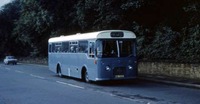 Vehicle reminder shot for this posting
Vehicle reminder shot for this posting
31/10/16 - 08:21
Several Seddon buses went to Central America in the late 60’s. Places like San
Salvador, Nicaragua. They went up to 8,000 feet on journeys.
My boyfriend/husband was the
engineer at the time and went with them, We have the photos.
Janet Wood
31/10/16 - 15:10
I’m sure we’d like to see a couple, Janet, if you feel like posting them.
Chris Hebbron
